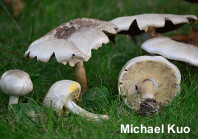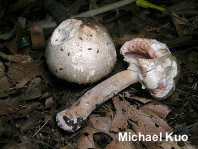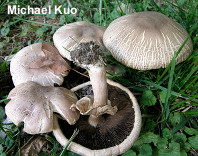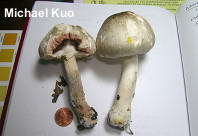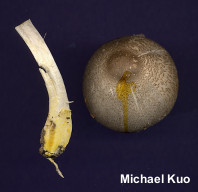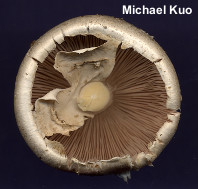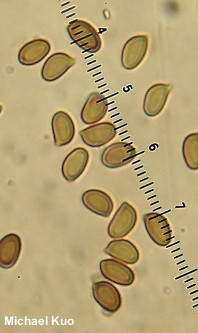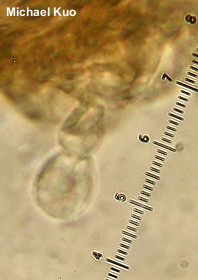| Major Groups > Gilled Mushrooms > Dark-Spored > Agaricus > Agaricus placomyces |

|
Agaricus placomyces [ Basidiomycota > Agaricales > Agaricaceae > Agaricus . . . ] by Michael Kuo This common species of Agaricus is found east of the Rocky Mountains, and can be identified—at least tentatively—through a combination of features. Like many species in the genus its cap is brownish, with a darker center. Depending on weather conditions, exposure to sunlight, and idiosyncrasies, the brown covering may break up into aggregations and scales, sometimes exposing a whitish ground color so that the cap appears from a distance to be whitish with a brown center. The surfaces of Agaricus placomyces bruise yellow when the mushrooms are fresh, and the flesh in the base of the stem is usually yellow when sliced. The odor is phenolic, especially in the base of the stem—but if, like me, you have trouble detecting this odor, never mind. The stature of Agaricus placomyces is tall, but it is not notably "skinny"; its stem, at maturity, is usually over 1 cm thick. There are several very similar species in eastern North America. These include Agaricus kriegeri, which features darker brown, more prominent scales, a slightly stockier stem, and, under the microscope, sphaeropedunculate cheilocystidia—and Agaricus approximans, which is usually a bit smaller (caps 3–10 cm across) and features yellow staining that becomes brownish orange. Two skinny-stemmed, similar species are the southeastern states' Agaricus pocillator (with a cup-like bulb at the stem base) and, in the southeast and Midwest, Agaricus leptocaulis (usually featuring a small, round bulb). Similar species in western North America include Agaricus deardorffensis and Agaricus buckmacadooi. Description: Ecology: Saprobic; growing scattered or gregariously under hardwoods or conifers—usually in woods, but also under planted trees in lawns and other urban settings; summer and fall; probably widely distributed in eastern North America. The illustrated and described collections are from Minnesota and Illinois. Cap: 6–14 cm; convex, becoming broadly convex or nearly flat; dry; covered with radiating grayish brown pigment, especially over the center, but breaking up with development to form pigment streaks and fibrils; whitish underneath, or pinkish in wet weather; often yellowing when rubbed repeatedly (especially on the margin). Gills: Free from the stem; crowded; short-gills frequent; whitish at first, becoming pink and eventually brown; when young covered by a rubbery, whitish partial veil that can develop yellow-then-brown stains. Stem: 7–11 cm long; 1–2.5 cm thick; more or less equal, or with a slightly enlarged base (but not typically with an abrupt bulb); bald; whitish to brownish; bruising yellow and then slowly brown where handled, especially at the base; with a persistent whitish ring. Flesh: White throughout; staining bright yellow in the base. Odor and Taste: Odor phenolic, or not distinctive. Chemical Reactions: KOH yellow on cap surface. Spore Print: Brown. Microscopic Features: Spores 5–6 x 3.5–4.5 µm; ellipsoid; smooth; thick-walled; brown in KOH. Basidia 4-sterigmate. Cheilocystidia 15–30 x 4–10 µm; clavate to subglobose; septate; smooth; thin-walled; hyaline in KOH. Pileipellis a cutis; elements 2.5–7.5 µm wide, smooth, brownish to golden in KOH. REFERENCES: Peck, 1878. (Saccardo, 1887; Kauffman, 1918; Freeman, 1979; Smith, Smith & Weber, 1979; Phillips, 1991/2005; Lincoff, 1992; Horn, Kay & Abel, 1993; Barron, 1999; Kerrigan et al., 2005; McNeil, 2006; Miller & Miller, 2006; Kuo & Methven, 2014; Kerrigan, 2016; Baroni, 2017; Woehrel & Light, 2017.) Herb. Kuo 07200201, 07230303, 09280606, 07041301, 09211401. This site contains no information about the edibility or toxicity of mushrooms. |
© MushroomExpert.Com |
|
Cite this page as: Kuo, M. (2018, January). Agaricus placomyces. Retrieved from the MushroomExpert.Com Web site: http://www.mushroomexpert.com/agaricus_placomyces.html |
